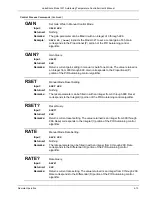
Lake Shore Model 321 Autotuning Temperature Controller User’s Manual
4-18
Remote Operation
Curve Commands
(Continued)
CURV11
(Continued)
To view a typical output after using this command, refer to the example under the
CURV? command. When entering, omit the temperature coefficient, number of
points, and endpoints.
The Model 321 determines and stores whether the curve is a positive or negative
coefficient curve. Based on temperature coefficient, the Model 321 then stores
the curve end points and also adds the number of points.
INPUT TYPE
UNITS
CONVERSION
Silicon Diode
Voltage
Input range is 0.00000 to 6.00000.
Platinum Resistance
Input range is 0.00 to 299.99
Ω
. 0.00
Ω
looks
like 0.00000 and 299.99
Ω
looks like 2.99990
(0.01 times R).
Thermocouple Millivolts
Input range is –45 to +45. Add 45 mV to make
all positive 0–90 mV and multiply by 100 to
make look like 0–9.00000 V. For example, a
thermocouple voltage of 0.0000 mV would be
entered as 4.50000 V. Temperature should be
stored as K
÷
2.
To aid in the automated loading of the User Curve, a QuickBASIC Curve Loading
Program is provided in Paragraph 4.3.
CURV?
Curve Number Information Query.
Input:
CURV? XX
Returned:
AA,SB0CCCCCCCCCCCCCCC,D,XX,Y.YYYYY,ZZZ.Z
Remarks:
User must provide curve number (00 thru 12) with query. The instrument will
return header line and all point information for that curve. Information returned is
defined as follows:
A = Curve number:
The value will be from 00 to 11.
B = Setpoint Limit
0 = 325 K, 1 = 375 K, 2 = 475 K, 3 = 800 K, and
9 = 999 K. The 9 should be used for all thermocouples.
0 =
For the Model 321, the third character should be the
number “0” for all sensors except thermocouples where
the number should be “9.’
C = Curve description: 15 character information line. You do not have to use all
15 characters, but there must be at least 1 character.
D = Temp. coefficient: N represents negative temperature coefficient, while P
represents positive.
X = Number of points: The number of data points for that particular curve
(usually 31, but can be up to 99).
Y = Units:
The value will be voltage or R
equiv
. (Refer to CURV
Command). The value will have 1 character before the
decimal place and 5 after it (0.00000).
Z = Temperature:
The value will have 3 places before the decimal point
and one after it (000.0).















































